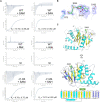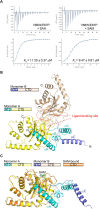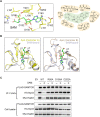Molecular mechanism of S-adenosylmethionine sensing by SAMTOR in mTORC1 signaling
- PMID: 35776786
- PMCID: PMC10883374
- DOI: 10.1126/sciadv.abn3868
Molecular mechanism of S-adenosylmethionine sensing by SAMTOR in mTORC1 signaling
Abstract
The mechanistic target of rapamycin-mLST8-raptor complex (mTORC1) functions as a central regulator of cell growth and metabolism in response to changes in nutrient signals such as amino acids. SAMTOR is an S-adenosylmethionine (SAM) sensor, which regulates the mTORC1 activity through its interaction with the GTPase-activating protein activity toward Rags-1 (GATOR1)-KPTN, ITFG2, C12orf66 and SZT2-containing regulator (KICSTOR) complex. In this work, we report the crystal structures of Drosophila melanogaster SAMTOR in apo form and in complex with SAM. SAMTOR comprises an N-terminal helical domain and a C-terminal SAM-dependent methyltransferase (MTase) domain. The MTase domain contains the SAM-binding site and the potential GATOR1-KICSTOR-binding site. The helical domain functions as a molecular switch, which undergoes conformational change upon SAM binding and thereby modulates the interaction of SAMTOR with GATOR1-KICSTOR. The functional roles of the key residues and the helical domain are validated by functional assays. Our structural and functional data together reveal the molecular mechanism of the SAM sensing of SAMTOR and its functional role in mTORC1 signaling.
Figures




Similar articles
-
Structures and Functions of the Human GATOR1 Complex.Subcell Biochem. 2024;104:269-294. doi: 10.1007/978-3-031-58843-3_12. Subcell Biochem. 2024. PMID: 38963491 Free PMC article. Review.
-
SAMTOR is an S-adenosylmethionine sensor for the mTORC1 pathway.Science. 2017 Nov 10;358(6364):813-818. doi: 10.1126/science.aao3265. Science. 2017. PMID: 29123071 Free PMC article.
-
PRMT1 orchestrates with SAMTOR to govern mTORC1 methionine sensing via Arg-methylation of NPRL2.Cell Metab. 2023 Dec 5;35(12):2183-2199.e7. doi: 10.1016/j.cmet.2023.11.001. Epub 2023 Nov 24. Cell Metab. 2023. PMID: 38006878 Free PMC article.
-
KICSTOR recruits GATOR1 to the lysosome and is necessary for nutrients to regulate mTORC1.Nature. 2017 Mar 16;543(7645):438-442. doi: 10.1038/nature21423. Epub 2017 Feb 15. Nature. 2017. PMID: 28199306 Free PMC article.
-
Mechanism of Activation of Mechanistic Target of Rapamycin Complex 1 by Methionine.Front Cell Dev Biol. 2020 Aug 11;8:715. doi: 10.3389/fcell.2020.00715. eCollection 2020. Front Cell Dev Biol. 2020. PMID: 32850834 Free PMC article. Review.
Cited by
-
Ragopathies and the rising influence of RagGTPases on human diseases.Nat Commun. 2024 Jul 10;15(1):5812. doi: 10.1038/s41467-024-50034-4. Nat Commun. 2024. PMID: 38987251 Free PMC article. Review.
-
Mechanisms and rationales of SAM homeostasis.Trends Biochem Sci. 2025 Mar;50(3):242-254. doi: 10.1016/j.tibs.2024.12.009. Epub 2025 Jan 15. Trends Biochem Sci. 2025. PMID: 39818457 Review.
-
The role of amino acids in skeletal muscle health and sarcopenia: A narrative review.J Biomed Res. 2024 Oct 22;39(3):229-241. doi: 10.7555/JBR.38.20240167. J Biomed Res. 2024. PMID: 39433511 Free PMC article.
-
Peripheral and Central Impact of Methionine Source and Level on Growth Performance, Circulating Methionine Levels and Metabolism in Broiler Chickens.Animals (Basel). 2023 Jun 12;13(12):1961. doi: 10.3390/ani13121961. Animals (Basel). 2023. PMID: 37370471 Free PMC article.
-
Structures and Functions of the Human GATOR1 Complex.Subcell Biochem. 2024;104:269-294. doi: 10.1007/978-3-031-58843-3_12. Subcell Biochem. 2024. PMID: 38963491 Free PMC article. Review.
References
MeSH terms
Substances
LinkOut - more resources
Full Text Sources
Molecular Biology Databases

